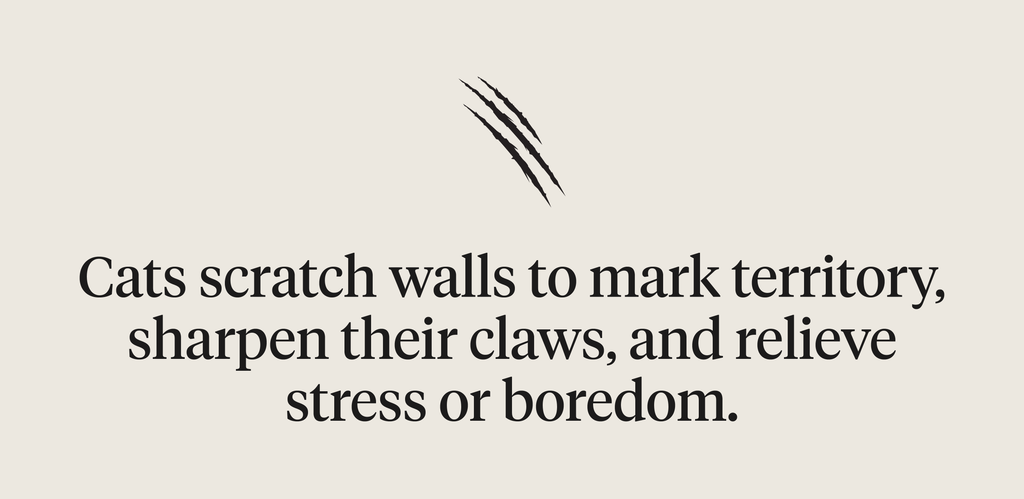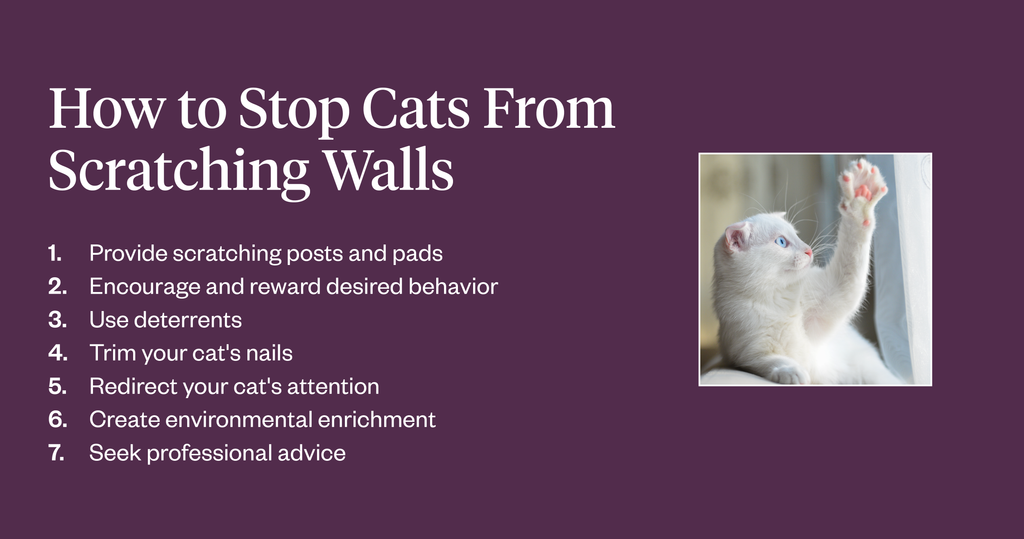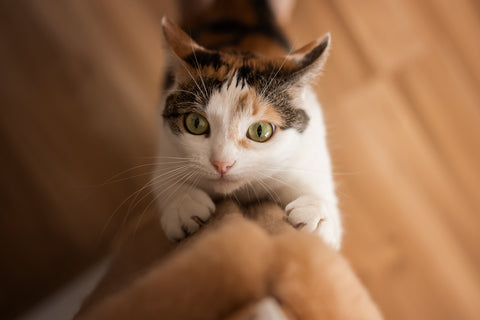11 Min Read
Why Does my Cat Scratch the Wall?
Key takeaway

Why pet owners are switching to online vet care with Dutch
-
Prescriptions delivered free to you
-
Fast access to Licensed Vets over video
-
Unlimited video visits and follow-ups
Cats scratch walls for several reasons, primarily to mark territory, sharpen their claws, and relieve stress or boredom. This behavior is natural for cats and serves various purposes in their daily lives. From Maine Coons to Peterbalds and every breed in between, all cats scratch. Understanding why cats engage in wall scratching can help you address their needs and provide more appropriate outlets for this behavior.
If you're asking yourself, "Why does my cat scratch the wall?" Keep reading to discover why your cat engages in this behavior and some effective strategies to redirect your cat's behavior and create a happy living environment for both you and your feline friend.
Understanding Why Cats Scratch
If you're wondering, "Why is my cat scratching the walls?" It's first important to understand why cats scratch. Cats scratch for various reasons, each serving specific purposes essential to their well-being and natural instincts. So, if your cat is scratching the walls, there are several potential reasons.
Cats have scent glands in their paw pads and scratching allows them to leave their scent on surfaces. By scratching furniture, walls, or other objects, cats mark their territory, ultimately communicating their presence to other cats that may be in the area.1
Scratching also helps cats shed the outer layer of their claws, keeping them sharp and healthy.2 It's a natural way for them to maintain the length and condition of their claws.
In addition to claw maintenance and territory marketing, your cat may be scratching the walls to stretch their muscles and flex their paws, promoting flexibility and relieving tension.2 This is an instinctive behavior that helps them stay physically fit and agile.
Cats may also scratch as a way to release pent-up energy, frustration, or stress.2 It serves as a form of self-soothing and can help them cope with anxiety or boredom.
So, if you're wondering, "Why does my cat scratch the wall?" it could be for any one of these reasons. Of course, you probably don't want your cat scratching the wall, which is why understanding this normal behavior is so important. Instead of scolding your cat, there are several techniques you can use to redirect the instinctive scratching behavior to something more suitable.

How to Stop Cats From Scratching Walls
Now that you have the answer to your question, "Why do cats scratch walls?", the next step is to learn how to prevent it. While scratching is a normal cat behavior, there's a point when scratching becomes a destructive behavior. If your cat is scratching walls, providing appropriate outlets and alternatives to redirect this behavior is essential. Here are a few ways to stop cats from scratching walls:
1. Provide scratching posts and pads
Giving your cat something else to scratch can redirect their behavior.2 When selecting scratching posts or pads for your cat, consider their size, height, and stability. Cats may prefer tall scratching posts that allow them to stretch fully when scratching.
Choose scratching posts that won't wobble or tip over during use.3 Additionally, offer your cat a variety of scratching surfaces to accommodate your cat's preferences. Experiment with different styles, like horizontal and vertical posts, unique shapes, and various textures to find one your cat enjoys the most.2 The more they like scratching their scratching posts, the less likely they are to continue scratching the walls.
2. Encourage and reward desired behavior
Positive reinforcement isn't just something that works on dogs; it can be a powerful tool for shaping your cat's behavior. Whenever you catch your cat using a scratching post or pad, praise them enthusiastically and offer treats or cat toys as rewards.
Make the experience of using scratching posts enjoyable and rewarding for your cat by incorporating playtime, treats, or catnip into their scratching sessions. Over time, your cat will learn to associate scratching posts with positive experiences and choose them over walls or furniture.
3. Use deterrents
Deterrents can help discourage cats from scratching walls. Apply double-sided tape, aluminum foil, or plastic sheeting to the walls in areas where your cat tends to scratch.2 These materials create an unpleasant texture that cats dislike and can deter them from scratching in those locations.
4. Trim your cat's nails
Since cats scratch walls to maintain their nails, trimming their nails may make them less likely to scratch.4 Regular nail trimming maintains your cat's claws and reduces the damage caused by scratching. Use cat-specific nail clippers to trim the sharp tips of your cat's claws every few weeks.
When trimming their nails, be careful not to cut into the quick, as it can cause pain and bleeding. If you're unsure how to trim your cat's nails, consult your veterinarian or a professional groomer.
5. Redirect your cat's attention
If you see your cat scratching walls, gently redirect them to a nearby scratching pad or post. You can use a toy or a treat to lure them away from the wall and encourage them to engage in more appropriate scratching behavior.
Consistency is key, so be patient but persistent with your cat and continue to redirect them as needed.
6. Create environmental enrichment
Cats may scratch walls and other objects out of boredom or frustration, so providing environmental enrichment can help alleviate these feelings and reduce the urge to scratch walls. Offer interactive toys, puzzle feeders, and vertical spaces for climbing and exploration. You can rotate toys regularly to keep your cat stimulated and engaged.
7. Seek professional advice
If you've tried multiple strategies to stop your cat from scratching the walls without success, consider seeking advice from a veterinarian. They can assess your cat's behavior, identify any underlying issues contributing to the undesirable behavior, and develop a personalized behavior modification plan.
FAQs
How do I stop my cat from scratching the walls and doors?
Provide multiple scratching posts and pads with varying textures, heights, and stability to stop your cat from scratching the walls and doors. Encourage and reward your cat for using these designated scratching surfaces, and consider using deterrents when necessary.
You should also trim your cat's nails and redirect their attention to appropriate scratching surfaces when needed.
Additionally, creating a stimulating environment with toys, climbing structures, and interactive activities to prevent boredom and frustration can prevent undesirable scratching behaviors.
If the problem persists, consider getting advice from your vet.
How can I tell if my cat's wall scratching is a sign of a health issue?
The only way to know whether your cat's wall scratching behavior is a sign of a health issue is by consulting a vet. However, some signs may suggest a health problem underlying the behavior. These can include excessive scratching accompanied by other symptoms like lethargy, changes in appetite, weight loss, or unusual vocalizations.
Additionally, if your cat appears to be in discomfort or distress while scratching, you should seek veterinary attention as soon as possible.
Keep an eye on your cat's overall well-being and behavior, and don't hesitate to schedule a vet visit if you have any concerns about their health.
Could my cat be scratching the walls due to stress or anxiety?
While scratching is normal behavior, anxiety can contribute to why your cat is scratching the walls. Cats may exhibit this behavior as a way to cope with stressors in their environment or alleviate anxiety.
Changes in their surroundings, such as moving to a new home, adding new pets or family members, loud noises, or disrupting their routine, can all trigger stress or anxiety in cats, leading to behaviors like wall scratching.
Providing a calm and enriched environment with a sanctuary spot, vertical spaces, and opportunities for mental stimulation and physical activity can help reduce stress levels in cats.
Additionally, you might consider using pheromone diffusers or supplements recommended by your veterinarian to promote relaxation and reduce cat anxiety.
Should I discipline my cat for scratching the walls?
You should never discipline your cat for scratching the walls. Scratching is a natural behavior for cats, and punishing them for it can lead to stress, fear, and other behavioral issues. Instead of discipline, provide appropriate outlets for scratching behavior, such as scratching posts or pads, and encourage them to use them regularly.
Redirect your cat's attention to these designated scratching surfaces whenever they attempt to scratch the walls. Positive reinforcement and redirection are more effective and humane ways to address unwanted behavior in cats.
Is declawing a viable solution to prevent wall scratching?
Declawing is not a viable solution to prevent your cat from scratching the walls, and it's widely considered inhumane and unnecessary. Declawing involves the surgical removal of the last bone of each toe and can lead to serious physical and behavioral problems in cats. It can result in chronic pain, lameness, arthritis, and behavioral issues.3
Declawing also doesn't address the underlying reasons for scratching behavior, such as the need to mark territory, maintain claws, or relieve stress. Instead of declawing, provide appropriate scratching surfaces like posts or pads.
At what point should I seek professional help for my cat's wall scratching behavior?
You should consider seeking professional help for your cat's wall scratching behavior if the behavior persists despite attempts to redirect it with appropriate scratching surfaces and alternatives. Remember, patience is key, so don't give up too soon. However, if you feel like you've done all you can, consulting with a vet might help.
Additionally, if your cat appears to be in distress or discomfort while scratching and is showing signs of pain, it's time to see a vet. It could mean that there's something wrong with their paws or nails that needs to be addressed.
Another reason to consider seeking professional help is if the scratching behavior is accompanied by other symptoms like lethargy, changes in appetite, weight loss, or your cat just seems to feel unwell. It could mean the scratching behavior is due to an underlying health issue.
Consulting with a vet can provide valuable insights and personalized recommendations tailored to your cat's specific needs. They can help identify any underlying health issues or behavioral problems contributing to the scratching and create a comprehensive plan to address it.

Final Notes
Understanding why cats scratch walls is crucial for providing them with an appropriate outlet. By offering alternatives like scratching posts, encouraging good behavior with positive reinforcement, and using deterrents, you can prevent your cat from scratching undesirable areas of your home.
Unfortunately, cats can sometimes scratch if they're suffering from underlying medical problems or anxiety, in which case regular alternatives may not be enough to prevent the behavior. In these cases, talk to a Dutch vet. Dutch telemedicine for pets offers a convenient way to consult a vet from the comfort of your home to ensure your cat receives the care and support they need. We also offer free prescription delivery for remembers from our online pet pharmacy to ensure your cat has everything they need to live a happy, healthy life.
Share
References
-
"Feline Behavior Problems: Destructive Behavior." Cornell University College of Veterinary Medicine, 2 Apr. 2019, www.vet.cornell.edu/departments-centers-and-institutes/cornell-feline-health-center/health-information/feline-health-topics/feline-behavior-problems-destructive-behavior.
-
"Destructive Scratching - Prevention and Solutions" PAWS, www.paws.org/resources/destructive-scratching/.
-
"Why Declawing Is Bad for Your Cat." The Humane Society of the United States, www.humanesociety.org/resources/why-declawing-bad-your-cat.
-
Bukowski, John A., and Susan Aiello. "Description and Physical Characteristics of Cats - Cat Owners." Merck Veterinary Manual, www.merckvetmanual.com/cat-owners/description-and-physical-characteristics-of-cats/description-and-physical-characteristics-of-cats.
